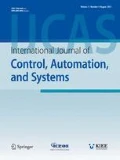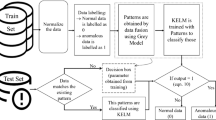Abstract
With the increasing presence and adoption of wireless sensor networks (WSNs), the demand of data acquisition and data fusion are becoming stronger and stronger. In WSN, sensor nodes periodically sense data and send them to the sink node. Since the network consists of plenty of low-cost sensor nodes with limited battery power and the sensed data usually are of high temporal redundancy, prediction- based data fusion has been put forward as an important issue to reduce the number of transmissions and save the energy of the sensor nodes. Considering the fact that the sensor node usually has limited capabilities of data processing and storage, a novel prediction-based data fusion scheme using grey model (GM) and optimally pruned extreme learning machine (OP-ELM) is proposed. The proposed data fusion scheme called GM-OP-ELM uses a dual prediction mechanism to keep the prediction data series at the sink node and sensor node synchronous. During the data fusion process, GM is introduced to initially predict the data of next period with a small number of data items, and an OPELM- based single-hidden layer feedforward network (SLFN) is used to make the initial predicted value approximate its true value with extremely fast speed. As a robust and fast neural network learning algorithm, OP-ELM can adaptively adjust the structure of the SLFN. Then, GM-OP-ELM can provide high prediction accuracy, low communication overhead, and good scalability. We evaluate the performance of GM-OP-ELM on three actual data sets that collected from 54 sensors deployed in the Intel Berkeley Research lab. Simulation results have shown that the proposed data fusion scheme can significantly reduce redundant transmissions and extend the lifetime of the whole network with low computational cost.
Similar content being viewed by others
References
R. Tan, G. Xing, B. Liu, J. Wang, and X. Jia, “Exploiting data fusion to improve the coverage of wireless sensor networks,” IEEE/ACM Trans. on Networking, vol. 20, no. 2, pp. 450–462, April 2012.
P. Ji, C. Wu, Y. Zhang, and F. Chen, “A lowenergy adaptive clustering routing protocol of wireless sensor networks,” Proc. of the 7th Conf. Wireless Communications, Networking and Mobile Computing, pp. 1–4, 2011.
M. Li, Z. Li, and A. V. Vasilakos, “A survey on topology control in wireless sensor networks: taxonomy, comparative study, and open issues,” Proceedings of the IEEE, vol. 101, no. 12, pp. 2538–2557, December 2013.
W. Zhou, C. Ji, J. Mou, D. Tong, and Y. Gao, “Adaptive target synchronization for wireless sensor networks with Markov delays and noise perturbation,” International Journal of Control, Automation, and Systems, vol. 11, no. 5, pp. 919–925, October 2013.
C. H. Yu and J. W. Choi, “Interacting multiple model filter-based distributed target tracking algorithm in underwater wireless sensor networks,” International Journal of Control, Automation, and Systems, vol.12, no. 3, pp. 618–627, June 2014.
G. Anastasi, M. Conti, M. Di Francesco, and A. Passarella, “Energy conservation in wireless sensor networks: a survey,” Ad Hoc Networks, vol. 7, no. 3, pp. 537–568, May 2009.
E. F. Nakamura, A. A. F. Loureiro, and A. C. Frery, “Information fusion for wireless sensor networks: Methods, models, and classifications,” ACM Computing Surveys, vol. 39, no. 3, Article 9, September 2007.
D. Chu, A. Deshpande, J. M. Hellerstein, and W. Hong, “Approximate data collection in sensor networks using probabilistic models,” Proc. of the 22nd International Conf. on Data Engineering, pp. 48–60, 2006.
A. Hui and L. Cui, “Forecast-based temporal data aggregation in wireless sensor networks,” Computer Engineering and Applications, vol. 43, no. 21, pp.121–125, July 2007.
G. Wei, Y. Ling, B. Guo, B Xiao, and A. V. Vasilakos, “Prediction-based data aggregation in wireless sensor networks: combining grey model and Kalman Filter,” Computer Communications, vol. 34, no. 6, p- p. 793–802, May 2011.
R. Wang, J. Tang, D. Wu, and Q. Sun, “GMLSSVM based data aggregation in WSN,” Computer Engineering and Design, vol. 33, no. 9, pp. 3371–3375, September 2012.
S. Zheng, W. Z. Shi, J. Liu, and J. Tian, “Remote sensing image fusion using multiscale mapped LSSVM,” IEEE Trans. on Geoscience and Remote Sensing, vol. 46, no. 5, pp. 1313–1322, May 2008.
Y. Miche, A. Sorjamaa, P. Bas, O. Simula, C. Jutten, and A. Lendasse, “OP-ELM: optimally pruned extreme learning machine,” IEEE Trans. on Neural Networks, vol. 21, no. 1, pp. 158–162, January 2010.
F. M. Tseng, H. C. Yu, and G. H. Tzeng, “Applied hybrid grey model to forecast seasonal time series,” Technological Forecasting and Social Change, vol. 67, no. 2, pp. 291–302, June/July 2001.
E. Kayacan, B. Ulutas, and O. Kaynak, “Grey system theory-based models in time series prediction,” Expert Systems with Applications, vol. 37, no. 2, pp. 1784–1789, March 2010.
Z. Zhao, J. Wang, J. Zhao, and Z. Su, “Using a grey model optimized by differential evolution algorithm to forecast the per capita annual net income of rural households in China,” Omega, vol. 40, no. 5, pp.525–532, October 2012.
Y. S. Lee and L. I. Tong, “Forecasting nonlinear time series of energy consumption using a hybrid dynamic model,” Applied Energy, vol. 94, pp. 251–256, June 2012.
P. Horata, S. Chiewchanwattana, and K. Sunat, “Robust extreme learning machine,” Neurocomputing, vol. 102, pp. 31–44, February 2013.
G. B. Huang, D. H. Wang, and Y. Lan, “Extreme learning machines: a survey,” International Journal of Machine Learning and Cybernetics, vol. 2, no. 2, pp. 107–122, June 2011.
H. Chen, J. Peng, Y. Zhou, L. Li, and Z. Pan, “Extreme learning machine for ranking: generalization analysis and applications,” Neural Networks, vol. 53, pp. 119–126, May 2014.
X. Luo, X. H. Chang, and H. Liu, “A Taylor based localization algorithm for wireless sensor network using extreme learning machine,” IEICE Trans. on Information and Systems, vol. E97D, no. 10, pp. 2652–2659, October 2014.
A. Grigorievskiy, Y. Miche, A. M. Ventelä, E. Séverin, and A. Lendasse, “Long-term time series prediction using OP-ELM,” Neural Networks, vol.51, pp. 50–56, March 2014.
LS-SVMlab Toolbox [Online]. Available: http://www.esat.kuleuven.be/sista/lssvmlab/.
S. Madden, Intel Berkeley research lab data. Intel Corporation, 2004 [Online]. Available: http://db.csail.mit.edu/labdata/labdata.html.
Author information
Authors and Affiliations
Corresponding author
Additional information
Xiong Luo received his Ph.D. degree from Central South University, Changsha, China, in 2004. From 2005 to 2006, he was with the Department of Computer Science and Technology, Tsinghua University, China, as a Postdoctoral Fellow. From 2012 to 2013, he was with the School of Electrical, Computer and Energy Engineering, Arizona State University, USA, as a Visiting Scholar. He currently works as an Associate Professor in the School of Computer and Communication Engineering, University of Science and Technology Beijing, China. His research interests include computational intelligence, intelligent control, and machine learning.
Xiaohui Chang is currently working toward a Master’s degree at the School of Computer and Communication Engineering, University of Science and Technology Beijing, China. Her research interests include wireless sensor network analysis and computational intelligence.
Rights and permissions
About this article
Cite this article
Luo, X., Chang, X. A novel data fusion scheme using grey model and extreme learning machine in wireless sensor networks. Int. J. Control Autom. Syst. 13, 539–546 (2015). https://doi.org/10.1007/s12555-014-0309-8
Received:
Revised:
Accepted:
Published:
Issue Date:
DOI: https://doi.org/10.1007/s12555-014-0309-8




